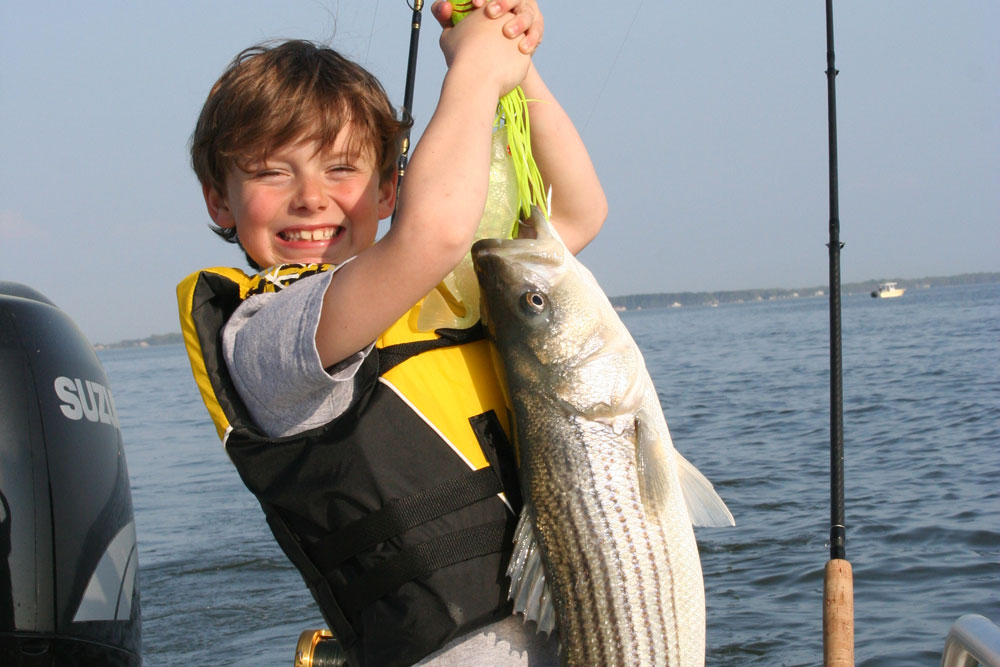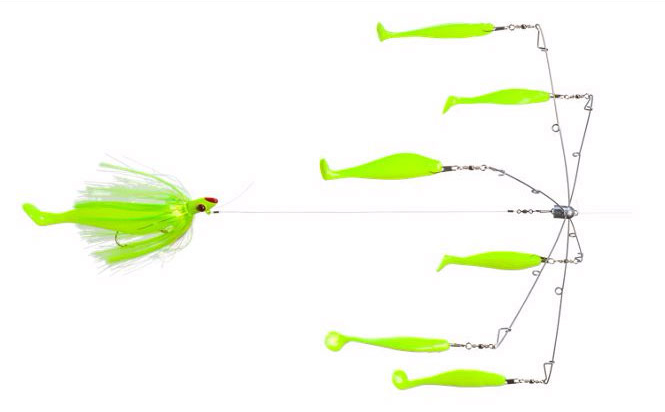Pop Quiz: You pull back the throttles, take out the rods, and get ready to set your striped bass summer trolling spread. You heard from a reliable source that the fish were running about 20 feet below the surface last week. Accordingly, you’re going to A) let your lines out waaaaay far back, B) spread all your lines throughout the water column, c) set the bulk of your lines to run at 20 feet, know for a fact that’s where they’ll actually be, and make sure a few lines are running shallower and deeper than that depth to cover all the bases until you get a bite or three and can adjust accordingly.

Unless you answer “c,” you’re not catching as many fish as you could be. Even when you have a pretty good idea of the fish’s depth it’s more or less meaningless if you don’t know for a fact where your lures are running. That’s critical data, if you want to kick some serious butt when you’re trolling.
Wait a sec — short of putting a depth gauge on your umbrella rig, you’ll never know exactly dead-nuts-on how deep your rig is running at, right? Maybe so. But you can get pretty dang accurate, using these tricks.
Trolling Depth Trick #1
There are two ways you can determine the exact depth/lure/speed relationship of a specific rig. The first is to deploy it to a specific distance, then troll up a gradual shelf or edge until it starts dragging bottom. Note the depth, and try to crank it in before it snags. The obvious danger of employing this tactic is that you may lose your rig.
The second way to nail down depth is less risky but more labor-intensive, and it depends on their being a hard thermocline in the area which isn’t too terribly deep. Tune up your depth finder’s sensitivity until you can clearly see the thermocline (read Electronic Countermeasures, to learn more about how to ID a thermocline on your meter if you're not sure how to do so). Then clip a thermometer onto your rig. Let out the length of line you think will be necessary to get your lure to the “target” depth (thermocline depth) and mark it. Troll five minutes, quickly pull the line, and check the thermometer. If the temperature it shows is close to the surface temperature set on your fishfinder, your estimate is off; try again, letting out more line each time until the thermometer comes up showing a notable temperature difference. Now you know how much line is necessary to hit the depth of the thermocline with that rig at that speed (all other variables remaining equal – more on this later).
Trolling Depth Trick #2
This one only works with level-winders, but it’s simple and highly effective. Use one of the above methods to establish a base-line, then as you set the line to that distance, count how many times the level-winder goes all the way back and forth across the spool. Every time you let out your lines (with the same type and weight rig tied on, of course) all you need to do to hit that target depth is watch the level winder and keep count.
If you don’t use level-winders all is not lost, you have two more options. First off you can spool up with pre-measured trolling lines that are color-coded. They usually have 10 feet of red followed by 10 feet of green followed by 10 feet of blue, and so on, so you can keep count by watching colors go by. The second option is to actually mark your line in 25- or 50-foot increments. A dab of nail polish will last for a little while, but isn’t a long-term solution. Wrapping a small section of waxed rigging thread works longer, but nor forever.
Trolling Depth Trick #3
First, a disclaimer: As with everything in fishing this is not an exact science, but a rule of thumb you can used when setting your lines to help make a better judgment as to where those lures are running is the “Rule of Fives.” When trolling at five mph, with 50 pound test line and five ounces of weight, set to 50 feet behind the boat, your lure will run about five feet under the surface.
Consider the following example: If you’re trolling a tandem rig tied with two five-ounce bucktails (5 x 2 = 10), and you let out 100 feet of line (double 50, so multiply by two again), according to the Rule it will run at about 20 feet below the surface (5 x 2 = 10 x 2 = 20). Does that sound a little deeper than it should? If it does, you’re probably an experienced troller and you know your stuff. You might also realize that this is because we haven’t accounted for a number of outside influences yet.
Consider the above example, but now note that you’re trolling against the current, which is moving at a two and a half mph. That means there’s actually seven and a half mph of water resistance on your lines, and that tandem rig is now running about five feet shallower. To get the lure back to its intended depth, you’ll have to let out another 25 feet of line. Then, you have to account for water resistance against the lure. Put a fat plastic shad on the bucktail and its water resistance and buoyancy both climb, by as much as 10- or 15-percent. Or if you have a gang lure like an umbrella rig on the end of your line, depending on the exact size and nature of the rig this figure could jump by as much as 30- or 40-percent and it’ll take significantly more line length (or added weight) to get to the target depth. And if you fish mono instead of braid, figure another 15- or 20-percent into the equation. Confusing? You bet—but if you keep the Rule of Fives in the back of your head as you apply the first two Depth Charge Tricks, you’ll begin to have a much more accurate idea of where your lures are running.

Trolling Depth Trick #4
Sometimes you’ll spot fish on the meter which are a bit deeper than your lures. If this is happening regularly you may want to drop the lures back but it now, temporarily getting the lures five or 10 feet deeper might be a good move. To make a quick change in lure depth without changing your lines, speed, or RPM setting, pull an abrupt turn of your boat towards the windward side, spinning the wheel as quickly as possible. As soon as the wheel hits the pins, reverse the turn. The bow won’t have time to come around very far into the wind before you straighten the wheel back up, but your boat’s headway will be significantly reduced for a short period of time. That will allow your lures to drop slightly in the water column. Alternatively, if you don’t mind varying your course make a slower turn. The lines on the inside of the turn will fall (though initially, the lines on the outside of the turn will rise).
Trolling Depth Trick #5
This is the simplest, and probably most effective, trick of all: once your lines are set you can negate the effects of most outside factors (including sea state, current, and wind) which influence lure depth to a great degree, by simply trolling cross-current and in the trough whenever possible.
Of course, there are other factors that will come into play and confound the best of anglers. Just when you have it all figured out, something will change and the data you’ve gathered up to that moment goes right out the window. Maybe a new set of props alters trolling speed at a given RPM, you re-spool with a different sized line, or some hot new lure comes out and no one knows at first how deep it tends to run. Whatever. But understanding these influences will help you gain a much better concept of how to put your lures right in front of the fish’s face. Do so, and you’re bound to catch more of ‘em.